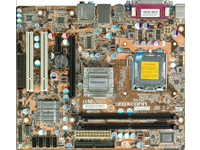G31 And E7200: The Real Low-Power Story
Foxconn G31MG-S
Foxconn’s G31 motherboard is called the G31MG-S. The second “G” stands for its “Green” series, which consists of three features that Foxconn refers to as 3G technology. GPS means Green Power Saving; GoD stands for Green on Demand; and GSM represents the Green System Mode. Green Power Saving refers to combining the motherboard with an efficient power supply to maximize power efficiency. Although we didn’t use a Foxconn PSU, we’re sure that our choice fits very well. Green on Demand is very much the same as implemented by other motherboard makers under different brands: voltage regulator phases are switched off when they’re not used, to increase efficiency per voltage regulator. Finally, Green System Mode refers to utilizing all power saving features that are available.


Motherboard Details
The board supports a FSB1600 setting, which we found to be absolutely reliable. However, this setting is not officially supported by the chipset. Foxconn uses only solid capacitors and a three-phase voltage regulator that we believe makes the most sense for a high efficiency system. The chipset components are passively cooled and there are only two memory sockets. While this isn’t upgrade-friendly, it ensures that you don’t install more memory modules than necessary. In addition, using two 2 GB DDR2-800 DIMMs will already take you to the G31 chipset’s 4 GB memory maximum anyway.


Upgrade Options
As with most other motherboards utilizing integrated graphics, the G31MG-S comes with an x16 PCI Express slot, which will host a discrete graphics card should you need serious 3D performance. An additional x1 PCIe slot and two 32-bit PCI slots accept other add-on cards. Foxconn implemented one of the two possible UltraATA/100 channels, which should still be sufficient. All four SATA/300 ports are available, but RAID is not supported.
The board clearly was designed for low-cost desktop applications, as it only features an analog D-SUB15 display output. We believe that at least a DVI port is mandatory, as the analog output decreases visual quality on high-resolution displays. All other interfaces are very much standard.


Power and Performance
Get Tom's Hardware's best news and in-depth reviews, straight to your inbox.
The performance of the Foxconn G31MG-S was very much in line with what we saw from Gigabyte’s board, so the benchmark differences are not worth mentioning. Idle power, however, was amazingly low on this board. While Gigabyte’s solution required a minimum of 38 W at all times, the Foxconn G31MG-S runs with as little as 31 W on idle—this represents 18% less idle power needed for Foxconn. Power required to finish the SYSmark 2007 Preview was smaller as well, hence this board won the battle for performance per watt. The only stain was the slightly higher peak power of 61 W as opposed to 60 W with the Gigabyte board.
Voltage power doesn’t seem to change between idle and max power: in both cases, CPU-Z reported 1.215 V. Foxconn still showed much better power efficiency with its product.


Current page: Foxconn G31MG-S
Prev Page Core 2 Duo E7200 Next Page Gigabyte GA-EG31MF-S2 (G31 Chipset)